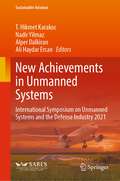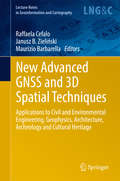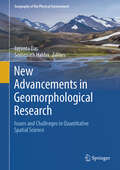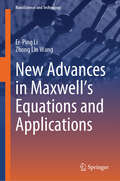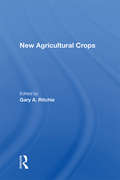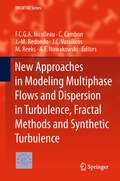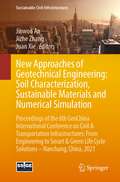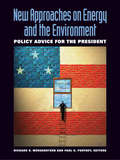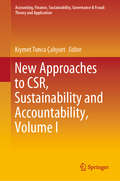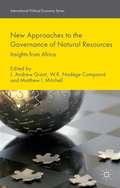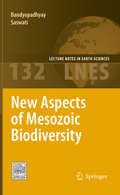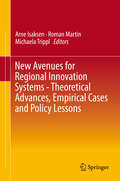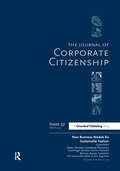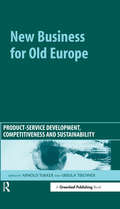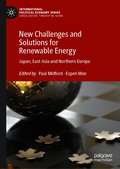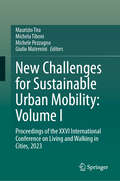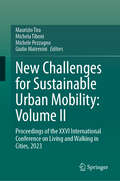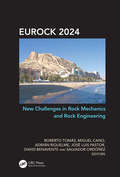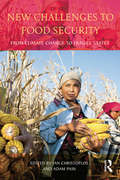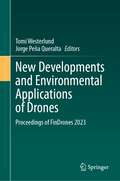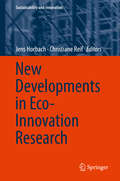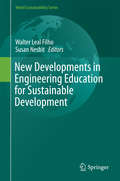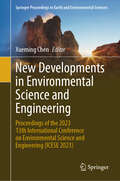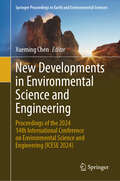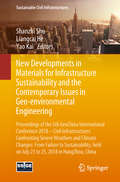- Table View
- List View
New Achievements in Unmanned Systems: International Symposium on Unmanned Systems and the Defense Industry 2021 (Sustainable Aviation)
by T. Hikmet Karakoc Alper Dalkiran Nadir Yilmaz Ali Haydar ErcanUnmanned systems are one of the fastest-growing and widely developing technologies in the world, offering many possibilities for a variety of research fields. This book comprises the proceedings of the 2021 International Symposium on Unmanned Systems and the Defense Industry (ISUDEF), a multi-disciplinary conference on a broad range of current research and issues in areas such as autonomous technology, unmanned aircraft technologies, avionics, radar systems, air defense, aerospace robotics and mechatronics, and aircraft technology design. ISUDEF allows researchers, scientists, engineers, practitioners, policymakers, and students to exchange information, present new technologies and developments, and discuss future direction, strategies, and priorities in the field of autonomous vehicles and unmanned aircraft technologies.Covers a range of emerging topics;Addresses current issues on autonomous vehicles and unmanned aircraft;Full proceedings of ISUDEF 2021 held at Howard University.
New Advanced GNSS and 3D Spatial Techniques
by Raffaela Cefalo Janusz B. Zieliński Maurizio BarbarellaThis book provides the latest research on and applications of advanced GNSS (Global Navigation Satellite System) and 3D spatial techniques in the fields of Civil and Environmental Engineering, Geophysics, Architecture, Archaeology and Cultural Heritage. It offers an updated reference guide on the above-mentioned topics for undergraduate and graduate students, PhDs, researchers, professionals and practitioners alike.
New Advancements in Geomorphological Research: Issues and Challenges in Quantitative Spatial Science (Geography of the Physical Environment)
by Jayanta Das Somenath HalderThere is an affirming transformation, basically in the form of core methodology, in recent geomorphological studies. This book on “New Advancement in Geomorphological Research: Issues and Challenges in Quantitative Spatial Science" asserts the contributing aspects of neo-modern developments related to applied geomorphology. This includes hydrological research, fluvial geomorphology, applied glacial geomorphology, changes in coastal geomorphology, regional to global level disaster and/or hazard monitoring with advanced models, landslide monitoring, geo-heritage site suitability, and bank and gully erosion detection. Contemporary developments in linking with the advanced developments in remote sensing and GIS, and with spatial science, in applied geomorphology and related sub-branches of earth science. Recently, global climate change phenomena (GCCP) impacted local to regional climatic events, resulting in sea-level rise, melting of glaciers, drastic river-course changes, the disappearance of the coastal area, and shrinkage of natural resources toss significant tests to sustaining human civilization. Meanwhile, modern monitoring technology and policy help-desk can support and minimize the present day's problems globally and also safeguard the natural environment's impending persistence in human society. So, this academic persuasion is a pioneer in minimizing the complications, like river course changes, glacier abolishment, geo-hazard crisis management, coastal area erosion management, geo-heritage conservation and management, and so on. Side by side, this present volume of the book caters a rational time-scale of the analyzed processes from mountain to coastal regions. And for better academic persuasion this will also incorporates the level of analysis, in the shape of `susceptibility' to `risk', with newly advanced methods. Therefore, appropriate cultivation of the knowledge of the application of GIScience for applied geomorphology and on the bigger aspect of the welfare of society and environment, and subjective nursing and administration can curtail the gap between science, policy, and the bottom-level scenario concerned. This current endeavor is also underlining the adaptation of hybrid techniques, remote sensing, statistical tools, and GIS technologies for the quantification of various issues related to several branches of applied geomorphology. This contributed piece includes focused and problem-oriented case studies to underline the versatility of changing geomorphological research, environmental resources, natural landscape, geo eco-system management, interconnected problems, and concerned applied vista at various spatiotemporal scales. The endorsed chapters, encircling both theoretical and applied aspects, help as guideline information for future research. Concisely, this book will offer traditional and advanced geospatial technologies used in earth science, atmospheric, lithospheric, hydrosphere, and biospheric contexts connected to applied geomorphology and for better management. This current book will be a commendable product from the belvedere of researchers, scientists, academic personnel, policymakers, advanced learners in advanced geoscience, earth science, applied geomorphology, remote sensing, environmental resources management, GIS, and hydrology.
New Advances in Maxwell’s Equations and Applications (NanoScience and Technology)
by Zhong Lin Wang Er-Ping LiThis book offers a comprehensive examination of ongoing advancements in theoretical and experimental approaches to Maxwell's equations. It focuses on three key aspects: quantum effects, scale effects, and kinetic effects, which exert subtle influences at microscopic levels. Addressing pressing challenges for future progress, the text explores the interplay of these phenomena within classical electromagnetism. The evolution of data communication and information technology has led to a demand for high-density, minimization, ultra-compact nano-photo-electronic integration. As electronic devices scale down to nanometer and sub-nanometer levels, classical Maxwell’s equations reveal quantum effects. This book provides insights into these advancements, focusing on potential applications in nano-scale electronic and optic devices. Tailored for physicists, engineering scientists, electronics engineers, and developers, this text serves as a valuable resource. It guides readers from classical Maxwell’s equations to their quantum-affected counterparts, providing essential insights for electromagnetic simulation and the design of nano-scale electronic and optic systems. With its blend of theoretical foundations and practical applications, this book equips professionals with the knowledge needed to apply these advancements in real-world scenarios.
New Agricultural Crops
by Gary A RitchieCurrent and projected worldwide shortages of energy, fertilizer, and irrigation water, coupled with a rapidly expanding population, are prompting agricultural scientists to seek, identify, and develop new crop species. Such crops should be energy- and water-efficient, well adapted to marginal lands, suited to intensive culture, and productive of ma
New Approaches in Modeling Multiphase Flows and Dispersion in Turbulence, Fractal Methods and Synthetic Turbulence
by J. M. Redondo A. F. Nowakowski C. Cambon F.C.G.A. Nicolleau J. C. Vassilicos M. ReeksThis book contains a collection of the main contributions from the first five workshops held by Ercoftac Special Interest Group on Synthetic Turbulence Models (SIG42. It is intended as an illustration of the sig's activities and of the latest developments in the field. This volume investigates the use of Kinematic Simulation (KS) and other synthetic turbulence models for the particular application to environmental flows. This volume offers the best syntheses on the research status in KS, which is widely used in various domains, including Lagrangian aspects in turbulence mixing/stirring, particle dispersion/clustering, and last but not least, aeroacoustics. Flow realizations with complete spatial, and sometime spatio-temporal, dependency, are generated via superposition of random modes (mostly spatial, and sometime spatial and temporal, Fourier modes), with prescribed constraints such as: strict incompressibility (divergence-free velocity field at each point), high Reynolds energy spectrum. Recent improvements consisted in incorporating linear dynamics, for instance in rotating and/or stably-stratified flows, with possible easy generalization to MHD flows, and perhaps to plasmas. KS for channel flows have also been validated. However, the absence of "sweeping effects" in present conventional KS versions is identified as a major drawback in very different applications: inertial particle clustering as well as in aeroacoustics. Nevertheless, this issue was addressed in some reference papers, and merits to be revisited in the light of new studies in progress.
New Approaches of Geotechnical Engineering: Proceedings of the 6th GeoChina International Conference on Civil & Transportation Infrastructures: From Engineering to Smart & Green Life Cycle Solutions -- Nanchang, China, 2021 (Sustainable Civil Infrastructures)
by Jinwoo An Jizhe Zhang Juan XieThe studies presented in this volume cover new approaches of geotechnical engineering introduced by researchers, engineers and scientists to address contemporary issues in geotechnical engineering such as the usage of sustainable materials in soil, soil characterization with new methods, and numerical simulations to predict material properties, etc. Studies were selected from the 6th GeoChina International Conference on Civil & Transportation Infrastructures: From Engineering to Smart & Green Life Cycle Solutions -- Nanchang, China, 2021.
New Approaches on Energy and the Environment: Policy Advice for the President
by Richard D. Morgenstern Paul R. PortneyWritten by economists and policy analysts at Resources for the Future, a Washington, DC, think tank with a tradition for independent, objective research, this collection of twenty-five 'memos to the President' offers constructive policy options for the elected administration on critical challenges related to energy, the environment, and natural resources. Each contributor to New Approaches on Energy and the Environment was asked to address the question: 'Based on your research and knowledge, what policy recommendation would you like to make to the next U.S. president?' Writing in advance of the 2004 election so as to keep their essays free of partisan interpretations, the authors were asked not to confine their suggestions to what the prevailing wisdom says is politically possible. They also took pains to make their ideas accessible to a busy president as well as a wide range of readers interested in a concise and authoritative overview of the nation's energy and environmental policy choices. The results are provocative, sometimes controversial, but highly readable essays on topics including climate change, oil dependency, electricity regulation, brownfields revitalization, forest service administration, air and water quality, and environmental health issues such as food safety and the growing threat of antibiotic resistance. When the President takes office in January, 2005, he will confront competing perspectives about the priorities and approaches that should apply to energy and environmental policy: Americans want cleaner air and water and healthy and attractive surroundings, but they also want inexpensive fuel, comfortable cars and houses, and continued economic growth. New Approaches on Energy and the Environment provides thought-provoking, commonsense contributions to debates about important energy and environmental issues confronting the U.S. today.
New Approaches to CSR, Sustainability and Accountability, Volume I (Accounting, Finance, Sustainability, Governance & Fraud: Theory and Application)
by Kıymet Tunca ÇalıyurtThis book provides a platform for discussing the challenges that organizations face in order to implement sustainability, ethics, and effective corporate governance, all of which are important elements of “standing out” from other companies. Examining the background of the New European Consensus on development with the new guiding motto ‘Our World, Our Dignity, Our Future’, the authors explore how this new legislation on sustainability issues around the world is forcing companies to deal directly with sustainability issues. The 2030 Agenda for Sustainable Development (2030 Agenda), adopted by the United Nations in September 2015, is the international community’s response to global challenges and trends in connection with sustainable development. With the Sustainable Development Goals (SDGs) at its core, the 2030 Agenda is a transformative political framework designed to eradicate poverty and achieve sustainable development globally. It balances the economic, social and environmental dimensions of sustainable development, including the key issues of governance and peaceful and inclusive societies, and recognizes the essential interlinkages between its goals and targets, i.e., that they must be implemented as a whole and not selectively. The respective chapters in this volume raise a number of questions regarding companies’ ability to implement sustainability, ethics, and effective corporate governance. Simultaneously, they explore how organizations must adapt to sustainability-related developments.
New Approaches to the Governance of Natural Resources
by J. Andrew Grant W.R. Nad�ge Compaor� Matthew I. MitchellThe resurgent economic and geopolitical importance of Africa is evidenced by the growing investment by China, India, the United States, Brazil, and other countries in the continent's various natural resources sectors, such as oil, biofuels, forestry, fisheries, and minerals. This book provides an in-depth analysis of the governance of natural resources in Africa and new insights for readers as they navigate the burgeoning research on global governance initiatives and regional and national strategies. Moreover, by carefully examining both theoretical and policy-related debates (and drawing upon public opinion data in countries such as Angola and South Sudan), the book makes important connections between theory and practice surrounding natural resource sectors. Consequently, it offers scholars, graduate students, policy-makers, think tank researchers, and media with a comprehensive and authoritative examination of the current research being conducted on the governance of natural resources in Africa.
New Aspects of Mesozoic Biodiversity
by Saswati BandyopadhyayThe proposed book is an edited volume which contains a thematic set of seven novel papers on contemporary issues of fossil vertebrates that includes new insights of tetrapod evolution during Palaeozoic and Mesozoic eras, discovery of new vertebrate fossils including dinosaur from different continents, new information on palaeo-osteohistology and palaeobiogeography of the Indian plate during the end Mesozoic. All the seven papers of the proposed book are extremely significant in the present milieu of interdisciplinary research in areas covering vertebrate palaeontology, palaeobiology, palaeoecology and palaeobiogeography. This book will give a glimpse of the present day state of the art knowledge of these branches of science. The papers of the proposed book are the results of pioneering researches of the concerned scientists who have excellently presented their ideas/views and new discoveries in their contributions making this book intellectually attractive to the researchers in these fields all over the world. The problems and issues addressed in these papers are of general interest, so this book will not only attract the vertebrate palaeontologists but will also arouse interest of the researchers and professionals dealing with evolutionary biology and biodiversity.
New Avenues for Regional Innovation Systems - Theoretical Advances, Empirical Cases and Policy Lessons
by Arne Isaksen Roman Martin Michaela TripplThis book discusses the latest theoretical advances in regional innovation research, presents empirical cases involving the development of regional innovation systems (RISs), and explores regional innovation policy approaches. Grounded in the extensive literature on RISs, it addresses state-of-the-art developments in light of recent theoretical advances in economic geography and related disciplines. Written in honor of Bjørn Asheim's seventieth birthday, the book includes novel and carefully selected chapters prepared by collaborators, colleagues and former PhD-students of one of the founding fathers of RIS research. Further, it makes a significant contribution to the academic debate on regional innovation and growth and offers valuable insights for scholars and policymakers alike.
New Business Models for Sustainable Fashion: A Special Theme Issue of The Journal of Corporate Citizenship (Issue 57)
by Miguel Angel Gardetti Esben Rahbek Gjerdrum PedersenThe fashion industry has not traditionally been associated with definitions of sustainable development and sustainability. The social and environmental challenges faced by the fashion industry concern the entire supply and demand chain, propped up by a throwaway consumer culture.In response to these sustainability challenges, some fashion companies have developed innovative social and environmental initiatives. While many of these initiatives are sympathetic, resourceful and hold real potential for generating social and environmental improvements, greater scale and scope is needed in order to bring about a more fundamental shift in current practices.This Special Issue of the Journal of Corporate Citizenship explores how sustainability can be a driver for exploring new business models within a single industrial setting, highlighting some of the sustainability initiatives that bring hope for a more sustainable future. New Business Models for Sustainable Fashion is a must-read for researchers and practitioners tackling the challenges of an industry in need of large-scale transformation.
New Business for Old Europe: Product-Service Development, Competitiveness and Sustainability
by Ursula Tischner Arnold TukkerSelling products used to be the standard way of doing business. Traditionally, it is left to the user to transform the purchase of a product into something that fulfils effectively a final-user need. Today, two streams of research – business management and sustainability – normally with very distinct perspectives on the world, have surprisingly converged to form a common conclusion: selling products is old-fashioned business. Companies should switch their focus to selling need fulfilment, satisfaction, or experiences. Or, in other words, selling integrated solutions or product-services. The business management literature argues that, by focusing on the integrated, final-client needs, and delivering integrated solutions fulfilling these needs, companies will be able to improve their position in the value chain, enhance added value of their offering, and improve their innovation potential. In a business world where many products are becoming equally well-performing commodities, this strategy is one of the ways to avoid a sheer competition on price – a type of competition that Europe never can win with emerging and low-cost economies such as China. In that sense, product-services can mean new business for old Europe. The sustainability knowledge stream argues that need-focused solutions could be inherently more sustainable than products. Product-services could offer the value of use instead of the product itself and decrease the environmental load in two ways. First, companies offering the service would have all the incentives to make the (product-)system efficient, as they get paid by the result. Second, consumers would be encouraged to alter their behaviour as they gain insight into all the costs involved with the use. Until today, the connections and interchange between the two research streams have been quite limited. The question of whether product-services truly are the avenue to a sustainable world is still under discussion. This book aims to develop a systematic view on this issue. The potential of product-services to enhance competitiveness and contribute to sustainable development prompted the EU to invest heavily in the theme under the EU's 5th Framework Programme (FP5; 1997-2002). A variety of research and development projects in the field were supported under the umbrella of the Sustainable Product Development Network (SusProNet). These included MEPSS (Methodology Product Service Systems); Home Services; HiCS (Highly Customerised Solutions); Prosecco (Product-Service Co-design); and Innopse (Innovation Studio and exemplary developments for Product-Service). The projects were undertaken by a mix of European research institutions and companies including Orange, Philips and Nokia. Some of these projects focused on developing methods that could help industries change their output from a product to a service. Others focused on the development of new product-services or solutions (HiCS, Prosecco, Innopse), and yet others tried to analyze under which circumstances product-services are likely to be implemented and accepted by consumers (Home Services). One project focused on dissemination of the concept to SMEs (Lean Services). Other projects focused purely on new product-service development, such as Brainfridge (an intelligent fridge managing its supply chain), ASP-NET (application service providers), Protex (intelligent enzymes) and IPSCON (receivers for wireless telephones). New Business for Old Europe brings together the key outputs from all of these groups to present a state-of-the-art collection on product-service development, prospects and implications for competitiveness and sustainability. The book has a number of aims. First, it attempts to bridge the gap between business and sustainability literature to lead to a better-founded understanding of the business drivers for embarking on product-service development, and its relation with sustainability and competitiveness. Second, the book reviews the large amount of studies that h
New Challenges and Solutions for Renewable Energy: Japan, East Asia and Northern Europe (International Political Economy Series)
by Paul Midford Espen MoeThis book identifies second stage challenges and opportunities for expanding renewable energy into a mainstay of electricity generation that can replace fossil fuels and nuclear power, comparing Japan with several countries in East Asia and Northern Europe. Environmentally sustainable renewable energy technologies have now overtaken fossil fuel and nuclear technologies in terms of total global investment, and the costs of these technologies and related ones (e.g. storage batteries) are rapidly falling. Yet renewable energy use varies greatly from country to country. Major second stage obstacles to replacing fossil and nuclear-fueled electricity generation include the lack of electricity grid capacity and storage assets. Opportunities and solutions include expanding grids regionally and internationally, building flexible smart grids that offer better demand management, and policies that promote the expansion of storage assets, especially grid batteries and hydrogen. In addition, two key factors – electricity market restructuring through unbundling transmission from electricity generating companies; and electricity market liberalization, especially for retail customers – allow consumers to choose power companies based not only on price, but also on method of generation, especially fossil or nuclear generation versus renewable energy.
New Challenges for Sustainable Urban Mobility: Proceedings of the XXVI International Conference on Living and Walking in Cities, 2023
by Maurizio Tira Michela Tiboni Michele Pezzagno Giulio MaterniniThis volume is the first of a two-volume set of the Proceedings of the XXVI International Conference on Living and Walking in Cities, held September 6-8 2023 at the University of Brescia, Italy. The LWC International Conference was first organized in 1994 at the Department of Civil and Environmental Engineering of the University of Brescia (IT). This year the LWC Conference has arrived at its XXVI edition. The Conference traditionally deals with the topics of urban mobility and quality of life in urban areas, with a specific focus on vulnerable road users. The LWC Conference allows researchers, experts, administrators, and practitioners to gather and discuss policy issues, best practices, and research findings from different perspectives. The main theme of the 2023 conference was “new challenges for sustainable urban mobility”, and the papers herein address the issue from a multidisciplinary perspective and cover a wide variety of related topics. These books are divided into four topical sections:o Transport Systems and Pedestrian Mobilityo Urban Regeneration through Active Mobilityo Public Transport: New Technologies and Economic Sustainabilityo Safe Mobility in Cities
New Challenges for Sustainable Urban Mobility: Proceedings of the XXVI International Conference on Living and Walking in Cities, 2023
by Maurizio Tira Michela Tiboni Michele Pezzagno Giulio MaterniniThis volume is the second of a two-volume set of the Proceedings of the XXVI International Conference on Living and Walking in Cities, held September 6-8 2023 at the University of Brescia, Italy. The LWC International Conference was first organized in 1994 at the Department of Civil and Environmental Engineering of the University of Brescia (IT). This year the LWC Conference has arrived at its XXVI edition. The Conference traditionally deals with the topics of urban mobility and quality of life in urban areas, with a specific focus on vulnerable road users. The LWC Conference allows researchers, experts, administrators, and practitioners to gather and discuss policy issues, best practices, and research findings from different perspectives. The main theme of the 2023 conference was “new challenges for sustainable urban mobility”, and the papers herein address the issue from a multidisciplinary perspective and cover a wide variety of related topics. These books are divided into four topical sections: o Transport Systems and Pedestrian Mobility o Urban Regeneration through Active Mobility o Public Transport: New Technologies and Economic Sustainability o Safe Mobility in Cities
New Challenges in Rock Mechanics and Rock Engineering
by Roberto Tomás Miguel Cano Adrián Riquelme José Luis PastorNew Challenges in Rock Mechanics and Rock Engineering includes the contributions presented at the ISRM European Rock Mechanics Symposium Eurock 2024 (Alicante, Spain, 15-19 July 2024), and explores cutting-edge advancements in rock mechanics and rock engineering. This comprehensive compilation covers various aspects of rock mechanics and rock engineering, including: rock properties, testing methods, infrastructure and mining rock mechanics, design analysis, stone heritage preservation, geophysics, numerical modeling, monitoring techniques, underground excavation support, risk assessment, and the application of EUROCODE-7 in rock engineering. Furthermore, it addresses areas like geomechanics for the oil and gas industry, applications of artificial intelligence, remote sensing methodologies and geothermal technology.New Challenges in Rock Mechanics and Rock Engineering covers the latest breakthroughs and tackles the new challenges in rock mechanics and rock engineering, is aimed at scientists and professionals in these fields, and serves as an essential resource for keeping up to date with industry trends and solutions.
New Challenges to Food Security: From Climate Change to Fragile States
by Ian Christoplos Adam PainFood security is high on the political agenda. Fears about societal insecurity due to food price increases and hunger, grave scenarios regarding the effects of climate change and general uncertainty about the impacts of investments in biofuels and so-call “land grabbing” on food prices and availability have meant that food security is now recognised as being a multifaceted challenge. This book is unique in that it will bring together analyses of these different factors that impact on food security. This volume will describe a range of different perspectives on food security, with an emphasis on the various meanings that are applied to food security “crisis”. The challenges to be reviewed include market volatility, climate change and state fragility. Analyses of responses to food security crises and risk will cover rural and urban contexts, arenas of national policy formation and global food regimes, and investment in land and productive technologies. This book is unique in two respects. First, it takes a step back from the normative literature focused on specific factors of, for example, climate change, agricultural production or market volatility to look instead at the dynamic interplay between these new challenges. It helps readers to understand that food security is not one discourse, but is rather related to how these different factors generate multiple risks and opportunities. Second, through the case studies the book particularly emphasises how these factors come together at local levels as farmers, entrepreneurs, consumers, local government officials and others are making key decisions about what will be done to address food security and whose food security will be given priority. The book will explore how food production and consumption is embedded in powerful political and market forces and how these influence local actions.
New Developments and Environmental Applications of Drones: Proceedings of FinDrones 2023
by Tomi Westerlund Jorge Peña QueraltaThis volume presents the conference proceedings from FinDrones 2023. The book highlights recent drone technology developments by experts and academicians for applications in agriculture, forestry, and other industries. This iteration of FinDrones presents research using autonomous drones in various fields from environmental monitoring to farm robotics and from photogrammetry to search and rescue missions. Emphasis is placed on contextualizing the conference presentations and content to Finland and the unique challenges typical to the region. The work will interest academicians, entrepreneurs, and professionals involved in remote sensing applications of unmanned aerial vehicles and enthusiasts of drone technological developments.
New Developments in Eco-Innovation Research (Sustainability and Innovation)
by Jens Horbach Christiane ReifEco-innovations are crucial for reducing the environmental damages arising from economic activities, and are one of the main drivers of a successful transition towards sustainable development and remedying essential climate change problems. This book provides an overview of recent advances in the rapidly growing field of eco-innovation research, adopts an interdisciplinary perspective and outlines the main future developmental trends. A broad range of topics are addressed, including a bibliometric analysis of eco-innovation research, the relationship between eco-innovation and corporate sustainability, eco-innovation system analysis, new evidence on the economic effects of eco-innovation, and the relevance of policy and policy mixes for eco-innovation activities. The book is dedicated to Klaus Rennings, one of the most important representatives of this field, who unexpectedly passed away in September 2015.
New Developments in Engineering Education for Sustainable Development
by Walter Leal Filho Susan NesbitThis book discusses essential approaches and methods in connection with engineering education for sustainable development. Prepared as a follow-up to the 2015 Engineering Education in Sustainable Development (EESD) Conference held in British Columbia, Canada, it offers the engineering community key information on the latest trends and developments in this important field. Reflecting the need to address the links between formal and informal education, the scholars and professionals who contribute to this book show by means of case studies and projects how the goal of fostering sustainable development in the context of engineering education can be achieved. In particular, they discuss the need for restructuring teaching at engineering‐focused institutions of higher education and provide practical examples of how to do so. The book places special emphasis on state-of-the art descriptions of approaches, methods, initiatives and projects from around the world, illustrating the contribution of engineering and affiliated sciences to sustainable development in various contexts, and at an international scale.
New Developments in Environmental Science and Engineering: Proceedings of the 2023 13th International Conference on Environmental Science and Engineering (ICESE 2023) (Springer Proceedings in Earth and Environmental Sciences)
by Xueming ChenThis book contains the peer-reviewed papers that were accepted and presented at the 2023 13th International Conference on Environmental Science and Engineering (ICESE 2023), held in Leuven, Belgium, September 8–10, 2023. The conference provides a forum for researchers and practitioners to address advances in the field of environmental science and engineering including problems, solutions, and research directions. The contents of the book cover emerging and diverse topics, including environmental systems approach, clean technologies, environmental restoration and ecological engineering, wastewater and sludge treatment, climate and climatic changes, atmospheric modeling and numerical prediction, waste minimization, recycling and reuse, solid waste management, carbon capture and storage, and sludge treatment and reuse.
New Developments in Environmental Science and Engineering: Proceedings of the 2024 14th International Conference on Environmental Science and Engineering (ICESE 2024) (Springer Proceedings in Earth and Environmental Sciences)
by Xueming ChenThis book consists of selected and peer reviewed papers which were presented at the 2024 14th International Conference on Environmental Science and Engineering (ICESE 2024). The conference was held in Hong Kong, China during September 20–22, 2024. It brought together innovative academicians and industrial experts in the field of environmental science and engineering in a common forum to promote their research and developmental activities. It also facilitated interchanging scientific information between researchers, developers, engineers, students, and practitioners working abroad. The book includes topics such as global environmental change and ecosystems management, environmental restoration and ecological engineering, water resources and river basin management, wastewater and sludge treatment, management of water treatment residuals, air pollution and control, carbon capture and storage, solid waste management, and technical aspects of treatment and disposal methods, among others.
New Developments in Materials for Infrastructure Sustainability and the Contemporary Issues in Geo-environmental Engineering: Proceedings of the 5th GeoChina International Conference 2018 – Civil Infrastructures Confronting Severe Weathers and Climate Changes: From Failure to Sustainability, held on July 23 to 25, 2018 in HangZhou, China (Sustainable Civil Infrastructures)
by Shanzhi Shu Liangcai He Yao KaiThis book contains research papers focusing on recent advances throughout the world in theories and technologies of geotechnical engineering and the relevant disciplines. Topics includes: numerical modeling, earthquake engineering, geomaterial application in soil improvement and geo-environmental engineering, foundation engineering, and geo-environmental engineering.. Papers were selected from the 5th GeoChina International Conference 2018 – Civil Infrastructures Confronting Severe Weathers and Climate Changes: From Failure to Sustainability, held on July 23 to 25, 2018 in HangZhou, China.
